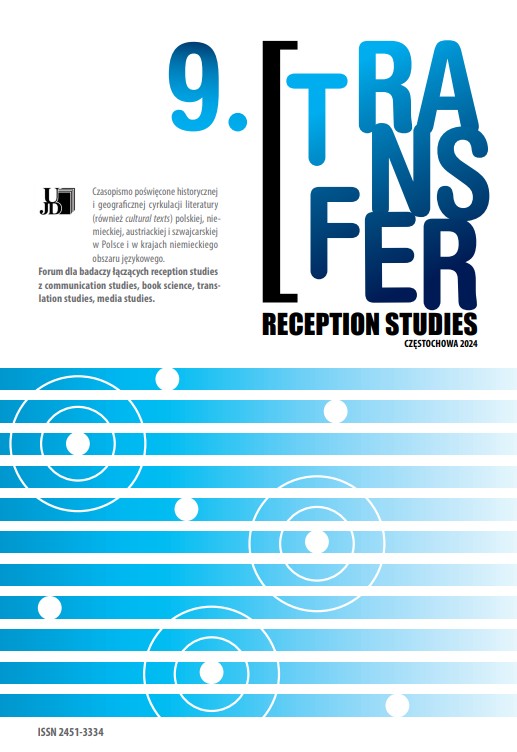Zaangażowanie poznawcze i afektywne czytelników w flash fiction
Abstrakt
Artykuł podejmuje próbę eksploracji flash fiction rozumianej jako mikronarracje, uznając ją za sposób pisania, który rozwinął się właściwie dopiero w ostatnich dziesięcioleciach, choć niepozbawiony jest znaczących poprzedników sięgających wielu wieków historii literatury. W artykule poruszono kwestie definiowania i cech formalnych flash fiction, zarysowując typowe struktury, a także spekulując, w jaki sposób flash fiction może angażować czytelnika w charakterystyczny sposób. Autor wychodzi z założenia, że zachowując podstawowe wymagania narracyjne (reprezentowanie wydarzeń i możliwość generowania mentalnych reprezentacji światów opowieści), flash fiction opiera się głównie na niedopowiedzeniu i fragmentacji, czyli narracji z niewystarczającą szczegółowością. Wymaga to od czytelników, pomimo zwięzłości tekstów flash fiction, przezwyciężania ciągłych wyzwań poznawczych,
a także doświadczania wysoce skondensowanych i intensywnych epistemicznych emocji narracyjnych.
Słowa kluczowe:
flash fiction, mikronarracje, recepcja czytelnika, poznanie , emocje, narratologia kognitywnaBibliografia
Bibliografia
Arnold, Sandra. Do it in a Flash: an Essay on the History and Definition of Flash Fiction. Accessed March 14, 2024. https://theshortstory.co.uk/do-it-in-a-flash-an-essay-on-the-history-and-definition-of-flash-fiction-by-sandra-arnold. Google Scholar
Baumbach, Sibylle. “The Economy of Attention and the Novel.” In New Ap-proaches to the Twenty-First-Century Anglophone Novel, edited by Sibylle Baumbach, and Birgit Neumann, 39–58. London–New York–Shanghai: Palgrave Macmillan, Cham, 2019. https://doi.org/10.1007/978-3-030-32598-5_3. Google Scholar
Behm-Steinberg, Hugh. “Taylor Swift.” Gulf Coast: A Journal of Literature and Fine Arts, 28.2 (Summer/Fall 2016). Accessed March 14, 2024. https://gulfcoastmag.org/journal/28.2/2015-barthelme-prize-winner-taylor-swift/. Google Scholar
Botha, Marc. “Microfiction.” In The Cambridge Companion to the English Short Story, edited by Ann-Marie Einhaus, 201–220. Cambridge Compan-ions to Literature. Cambridge: Cambridge University Press, 2016. https://doi.org/ Google Scholar
1017/CCO9781316018866.016 Google Scholar
Flash Fiction America, edited by James Thomas, Sherrie Flick, and John Du-fresne. New York: W.W. Norton & Co., 2023. Google Scholar
Herman, David. “Narrative Ways of Worldmaking.” In Narratology in the Age of Cross-Disciplinary Narrative Research, edited by Sandra Heinen, and Roy Sommer, 71–87. Berlin, New York: De Gruyter, 2009. https://doi.org/ Google Scholar
1515/9783110222432.71 Google Scholar
Hogan, Patrick Colm. Literature and Emotion. New York: Routledge, 2018. Google Scholar
Iser, Wolfgang. The Act of Reading: A Theory of Aesthetic Response. Balti-more: Johns Hopkins UP: 1976. Google Scholar
Jenkins, Henry. “Game Design as Narrative Architecture.” Computer, vol. 44, no. 3 (2004): 118–130. Google Scholar
Kiosses, Spyros. ”Towards A Poetics of Narrative Brevity: Short Story, Micro-fiction, Flash Fiction.” International Journal on Studies in English Lan-guage and Literature (IJSELL), vol. 9, no. 1 (January 2021): 9–18. https://doi.org/10.20431/2347-3134.0901002. Google Scholar
Labov, William & Joshua Waletzky . “Narrative Analysis: Oral Versions of Personal Experience.” In Essays on Verbal and Visual Arts, edited by June Helm. Seattle: U of Washington P, 1967. Google Scholar
Lucht, Bente. "Flash Fiction: Literary fast food or a metamodern (sub) genre with potential." In 2nd Human And Social Sciences at the Common Confer-ence, 222–225. 2014. Google Scholar
Porter Abbott, H. The Cambridge Introduction to Narrative (2nd ed.). Cam-bridge: Cambridge University Press, 2008, 13–27. Google Scholar
Prince, Gerald. "The Undernarrated and the Overnarrated." Style 57, no. 2 (2023): 131–140. muse.jhu.edu/article/901161. Google Scholar
Rembowska-Płuciennik, Magdalena. “O narracji w drugiej osobie – enak-tywnie.” Teksty drugie, no. 2 (2022): 54–70. DOI: https://doi.org/10.18318/ Google Scholar
td.2022.2.4. Google Scholar
Roche-Jacques, Shelley. “Flash Fiction as a Distinct Literary Form: Some Thoughts on Time, Space, and Context.” New Writing 21, no. 2 (2024): 171–89. DOI: https://doi.org/10.1080/14790726.2023.2293767. Google Scholar
Talmy, Leonard. Toward a Cognitive Semantics. Cambridge: MIT Press: 2000. Google Scholar
Statystyki
Abstract views: 0PDF downloads: 0
Licencja
Prawa autorskie (c) 2024 Transfer. Reception Studies

Utwór dostępny jest na licencji Creative Commons Uznanie autorstwa – Użycie niekomercyjne – Bez utworów zależnych 4.0 Międzynarodowe.
Podobne artykuły
- Tobiasz Janikowski, „Die Botin treuen Sinns“. Das Sehnsuchtsmotiv in der Musik der deutschen Romantik , Transfer. Reception Studies: Tom 7 (2022): Współczesne tęsknoty w literaturę wpisane
- Jolanta Pacyniak, Narracyjne struktury zagrożenia w powieści "1000 Serpentinen Angst" Olivii Wenzel , Transfer. Reception Studies: Tom 8 (2023): Lęk i strach we współczesnej literaturze niemieckojęzycznej, polskiej i irlandzkiej
- Mariana Yemelianova, Emocje czy rozum? W kierunku samopoznania (na marginesie Gry szklanych paciorków Hermanna Hessego) , Transfer. Reception Studies: Tom 6 (2021): AFEKTY 2 – WSPÓŁCZESNA KULTURA EMOCJI. TRANSFER. PRZEKŁAD. RECEPCJA
- Dana Radler, Życie „naznaczone” humorem: bohaterowie dzieł Johna McGaherna , Transfer. Reception Studies: Tom 5 (2020): AFEKTYWNA KULTURA. TRANSFER – PRZEKŁAD – RECEPCJA (LITERATURA NIEMIECKOJĘZYCZNA, ANGLOJĘZYCZNA I POLSKA)
- Agnieszka Jezierska-Wiśniewska, Kto się (nie) boi zmian klimatu. Nauka, esej i fikcja w walce o ocalenie Ziemi, planety ludzi (esej) , Transfer. Reception Studies: Tom 8 (2023): Lęk i strach we współczesnej literaturze niemieckojęzycznej, polskiej i irlandzkiej
- Bożena Anna BADURA, Redukcja estetyczna w narracji i imersja w najnowszej literaturze polskiej i niemieckiej , Transfer. Reception Studies: Tom 2 (2017)
- Anna Majkiewicz, Powieściowa historical fiction Christopha Ransmayra w polskim obiegu krytycznoliterackim , Transfer. Reception Studies: Tom 1 (2016): CYRKULACJA LITERATURY NIEMIECKOJĘZYCZNEJ I POLSKIEJ W XXI WIEKU
- Katarzyna LUKAS, Przekraczanie granic w przekładzie intersemiotycznym: powieść graficzna Dietera Jüdta Heimsuchung und andere Erzählungen von Bruno Schulz , Transfer. Reception Studies: Tom 3 (2018)
- Dorota Sośnicka, Pisarstwo będące próbą ‘tworzenia piękna' i 'szczęścia’: Tęsknota jako centralny motyw twórczości Ursa Widmera , Transfer. Reception Studies: Tom 7 (2022): Współczesne tęsknoty w literaturę wpisane
- Magdalena Bednorz, Poszukiwanie cyfrowej miłości. O wykorzystaniu tradycji romansu poszukiwań w wątkach romantycznych w Dragon Age: Origins , Transfer. Reception Studies: Tom 9 (2024): The Literature (of the) “now.” Interventions, Trends and Revisions
Możesz również Rozpocznij zaawansowane wyszukiwanie podobieństw dla tego artykułu.

